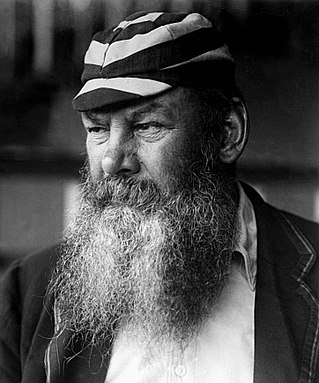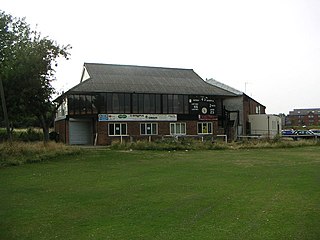Related Research Articles

William Gilbert Grace was an English amateur cricketer who was important in the development of the sport and is widely considered one of its greatest players. He was nominally amateur as a cricketer, but he is said to have made more money from his cricketing activities than any professional cricketer. He was an extremely competitive player and, although he was one of the most famous men in England, he was also one of the most controversial on account of his gamesmanship and moneymaking.
Gentlemen v Players was a long-running series of cricket matches that began in July 1806 and was abolished in January 1963. It was a match between a team consisting of amateurs and a team consisting of professionals that reflected the English class structure of the 19th century. Typically, the professionals were working class people who earned their living by playing cricket, while the amateurs were middle- and upper-class products of the public school system, who were supposedly unpaid for playing. The professionals were paid wages by their county clubs and/or fees by match organisers, while the amateurs claimed expenses. However, while rules to distinguish amateurs from professionals were established by Marylebone Cricket Club (MCC), the system of allowable expenses was both controversial and complex, enabling some leading amateurs to be paid more than any professional for playing cricket.

Bransby Beauchamp Cooper was a member of the Australian cricket team that played the inaugural Test match at the Melbourne Cricket Ground in 1877. Cooper was born in Dacca in what was then British India in 1844. He played first-class cricket as an amateur in England for Middlesex and Kent County Cricket Clubs before moving to Australia where he played for Victoria cricket team. He was a right hand batsman and wicket-keeper and the first Indian-born cricketer to play Test cricket.

George Frederick Grace was an English first-class cricketer active from 1866 to 1880 who played for Gloucestershire and the United South of England Eleven (USEE). He played in one retrospectively recognised Test match for England. He was born in Downend, near Bristol and died in Basingstoke, Hampshire. A right-handed batsman who bowled right arm fast roundarm, he appeared in 195 matches that are generally rated first-class for statistical purposes. In these matches, Grace scored 6,906 runs with a highest score of 189*. An outstanding fielder and occasional wicket-keeper, he held 170 catches and completed three stumpings. He took 329 wickets with a best performance of eight for 43.
County cricket teams representing Middlesex have been traced back to the 18th century, although for long periods the county was secondary to the London Cricket Club which played at the Artillery Ground. Middlesex teams played at various grounds throughout what is now the Greater London area. Islington and Uxbridge were often used but home matches were also played on Kennington Common and in Berkshire. Middlesex teams were less frequent in the 19th century until 1859 when the Walker family of Southgate became involved in county cricket.
1865 was the 79th season of cricket in England since the foundation of Marylebone Cricket Club (MCC). W. G. Grace made his debut as a first-class player and the new Lancashire County Cricket Club played its first match.
1868 was the 82nd season of cricket in England since the foundation of Marylebone Cricket Club (MCC). It featured the first organised group of Australian sportspeople to travel overseas, being an all-Aboriginal cricket team.
Anthony John Anstruther Wilkinson was an English barrister and amateur first-class cricketer.
Prince's Cricket Ground in Chelsea, London was a cricket ground, created by the brothers George and James Prince as part of the Prince's Club, on which 37 first-class matches were played between 1872 and 1878. The ground was built on in 1883. The boundaries of the site, laid out on the former Cattleugh's nursery gardens, are marked by Cadogan Square West, Milner Street, Lennox Gardens Mews, Walton Street and Pont Street.

George Wootton (1834–1924) was an English cricketer.

The Denis Compton Oval is a cricket ground located at the Shenley Cricket Centre in Shenley, Hertfordshire, England. The ground was opened by Denis Compton and the main ground was named in his honour. At the heart of the centre is the 19th-century pavilion, originally designed by the legendary cricketer W. G. Grace.

Bulls Head Ground is a cricket ground in Coventry, West Midlands. The first recorded match on the ground was in 1848, when Coventry played an All-England Eleven. It hosted its first first-class match in 1903, which was between Warwickshire and the Gentlemen of Philadelphia. From 1909 to 1919, the ground played host to 12 first-class matches. First-class cricket returned to the Bulls Head in 1990, and from 1990 to 1992 it hosted a further 3 first-class matches, the last of which was between Warwickshire and Middlesex.
Bank of England Ground is a cricket ground in Roehampton, London. The ground is owned by the Bank of England, and is part of the Bank of England Sports Centre. The first recorded match on the ground was in 1949, when South Women Second XI played the Women's Cricket Association.

Manor Fields is a cricket ground in Bletchley, Buckinghamshire. The first recorded match on the ground was in 1973, when Young England women played International XI women in the ground's only Women's One Day International.
Chiswick Park Cricket Ground was a cricket ground in Chiswick, London. The first recorded match on the ground was in 1886, when Chiswick Park played the Parsees during their tour of England.
Milnrow Road was a cricket ground in Rochdale, Lancashire. The first recorded match on the ground was in 1868, when the Gentlemen of Rochdale played Australian Aboriginals during their tour of England.
George Harman Jupp was an English cricketer. Jupp was a right-handed batsman who bowled roundarm slow, although with which hand he bowled with is unknown. He was born at Brentford, Middlesex.
W. G. Grace established his reputation in 1864 and, by 1870, was widely recognised as the outstanding player in English cricket.
Frank Silcock was an English first-class cricketer and a founding member of Essex County Cricket Club. Debuting in first-class cricket in 1864, Silcock made 41 appearances in first-class cricket from 1864–1879, scoring 776 runs and taking 79 wickets. Regarded as one of the best professionals of his time to play for Essex, he was instrumental in the foundation of Essex County Cricket Club in 1876 and played for the county until 1887. He later stood as an umpire in first-class matches between 1889–1892.